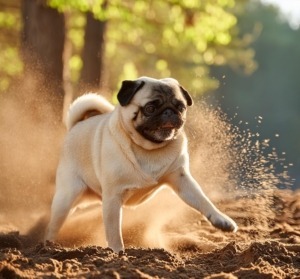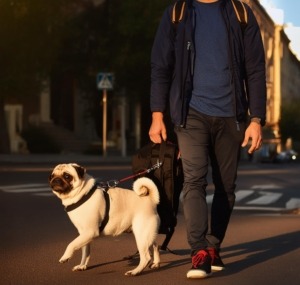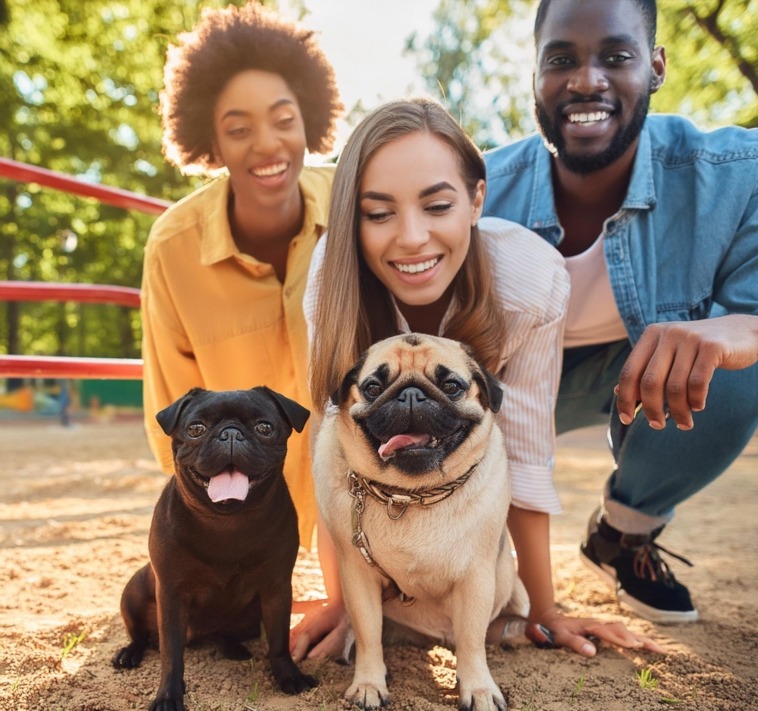Last updated on September 27th, 2024
Here’s an overview:
Introduction to Pug Socialization: Why It Matters
Understanding Pug Behavior and Temperament
Starting Early: Socializing Your Pug Puppy
Introducing Your Pug to New Environments
Creating Constructive Human Connections
Socializing Among Other Dogs: The Right Way To Go About It
Working On Common Socialization Challenges
Training techniques for confident pugs
The Role Of Play In Socialization
Monitoring Progress And Adjusting Strategies
Socialization for Adopted and Adult Pugs
Creating a Secure and Optimistic Social Experience
Conclusion: Summary Of The Journey Towards A Well-Socialized Pug
Introduction to Pug Socialization: Why It Matters
It is important that pugs are properly socialized so they can become well-adjusted, confident members of their families. Here’s what early socialization does for them:
- Interact Positively with Other Dogs: Prevents aggression and anxiety.
- Adapt to New Environments: Minimizes stress in unfamiliar situations.
- Develop Good Behavior: Encourages proper manners around people and pets.
- Builds Confidence: Reduces fearfulness and promotes a sense of security.
- Strengthens the Human-Animal Bond: Creates trust and deepens the connection between owner and pet.
Investing time in socializing a pug leads to a more enjoyable and fulfilling companionship.
Understanding Pug Behavior and Temperament
Pugs are known for being friendly dogs with affectionate personalities. They often seek physical contact, are sociable, enjoy being around humans. Their playful nature makes them great family pets too. Key points about pug behavior include:
- Affectionate: these dogs need lots of love!
- Playful: interactive toys or games will keep them entertained.
- Sociable: they’re naturally good with strangers and other animals alike.
- Stubborn: strong-willed, so patience is required when training them.
- Alert: Pugs are usually aware of their surroundings but aren’t aggressive in nature.
Understanding these traits can help you socialize and train your pug more effectively.
Starting Early: Socializing Your Pug Puppy
Socializing a pug puppy from an early age is essential if you want it to grow up into a well-adjusted adult dog.
- Exposure: introduce the pup to different places, sounds, surfaces etc.
- Animal interaction: controlled meetings with vaccinated dogs and friendly cats
- Training Classes: enroll the pup for puppy kindergarten classes
- Positive Experiences: use treats or praise them whenever they have good social interactions
- Routine: establish a consistent daily routine to build up security
Early socialization will prevent future behavior problems in your dogs life span.
Introducing Your Pug to New Environments
When introducing your pug to new environments, do it gradually so as not to overwhelm him/her with fear or stress. Start by taking them out one place at a time this aids in acclimatization hence reduces chances of being overwhelmed which may result toxiphobia (fear of new things).

Steps to Follow:
- Start Indoors: begin by introducing them to new rooms within the house first
- Short Outings: take them for short walks around quiet neighborhoods before exposing them public spaces like parks where there are many people milling about
- Public Spaces: slowly increase exposure levels e.g., we could go from visiting less crowded areas such as local parks then advance into city centers during peak hours
- Chemical-Free Areas: make sure that the new environment is free from any poisonous substances.
Key Considerations:
- Observe Behavior: watch out how they react under certain conditions and adjust accordingly
- Carry Treats: use treats as rewards for remaining calm during these sessions so that positive reinforcement can take place at all times
Creating Constructive Human Connections
It is very important to ensure that a pug interacts positively with humans. Here’s what need to be done by owners:
- Introduce the pug towards different individuals, including children as well as adults.
- Give rewards such as treats and praises during interaction
- Encourage gentle and respectful petting from kids
- Organize regular playdates to enhance social skills
- Join puppy classes in order to reinforce positive behavior
- Monitor and control the dog’s exposure to different environments
- Establish consistent calmness while socializing.
A well-socialized pug responds positively to human companionship thereby reducing anxiety levels and promoting balanced temperaments.
Socializing Among Other Dogs: The Right Way To Go About It
For a pug to interact well with other dogs calls for strategic planning.
- Early Introduction: This involves exposing pugs while they are still young so that they can have a positive view.
- Neutral Territory: Dogs should meet at neutral grounds so as not bring out territorial behaviours.
- Positive Reinforcement: Give treats or praise for staying calm and being friendly with each other.
- Body Language Observation: Watch closely both dogs’ body languages so that they feel comfortable together.
- Gradual Exposure: Do not let them stay for too long during the first few meetings since it may result into overstimulation.
- Consistent Playdates: Arrange frequent play sessions involving familiar dogs since this helps them learn more about social skills.
Working On Common Socialization Challenges
Socializing may pose challenges even for pugs just like any other dog. These problems should be identified early enough before they develop into something serious thus making your pet more adjusted to the environment.
Fear of Strangers
- New people ought to be introduced gradually.
- Positive reinforcement can be used through treats and praise.
- Initially keep brief all first-time encounters so that you do not overwhelm it.
Aggression Towards Other Dogs
- Enroll in controlled and well-supervised dog obedience classes.
- Let your pug watch other dogs first before allowing them to interact directly.
- Be more vigilant during all introductions.
Separation Anxiety
- Encourage independence through practice of short departures at the beginning
- Leave items like favourite toy or blanket which may provide comfort
- Set up a consistent routine to create security feeling
Training techniques for confident pugs
It can be fun to train pugs if done with right strategies whereby they respond well to positive reinforcement together with consistency. Some of the key methods include;
- Positive Reinforcement: Reward good behavior using treats or praise.
- Consistency: Use same commands as well as routines every time.
- Short Training Sessions: Stick around 5-10 minutes per session and keep it simple.
- Socialization: Expose pugs into different environments and other dogs too.
- Patience: Have patience throughout training process while avoiding harsh punishments.
- Basic Commands: Teach them “sit,” “stay,” and “come.”
Regular practice backed by encouragement will make your pug obedient and confident.
The Role Of Play In Socialization
Play is an important aspect in socializing pugs because it helps them learn cues for proper interaction with both humans and fellow canines. Through play they get:
- Communication Skills: By playing, pugs are able to read body language and understand vocal signals from other dogs.
- Confidence: Playing frequently enables them gain self-assurance when exposed to new places or situations.
- Problem Solving: Games like puzzle toys which challenge their minds assist in building cognitive abilities among these pets.
- Exercise And Health: Physical activities carried out during play-time help a lot in keeping healthy weight thus maintaining good physical shape of these animals.
- Bonding: Play creates stronger bonds between owners & their pets leading trustful relationships where each party knows its role better than before.
Monitoring Progress And Adjusting Strategies
- Owners should regularly assess how well their pugs are socializing. They should:
- Watch how they interact with other dogs or people.
- Note any signs of fear or aggression.

Use these findings to adjust training methods where necessary. If there is no change, consider:
- Changing environments.
- Introducing new stimuli gradually.
- Consulting professional trainers or vets for further advice.
Consistent use of positive reinforcement techniques is needed. Reward good behaviour with praise, toys or treats. Do not use punishment as it may worsen fear or anxiety. It is important to regularly review and modify pug socialization methods for continued success.
Routine and Consistency
When a routine is established during socialisation, it helps the pugs. Predictability creates feelings of safety and confidence; which in turn foster stable environments where they can grow. A consistent schedule also allows them to know what comes next thereby lowering their levels of nervousness.
Key Aspects of Routine and Consistency:
- Set Regular Meal Times: Feeding at the same time(s) every day helps establish a sense of stability for these pets who are known to have sensitive tummies.
- Consistent Training Times: Pugs should be trained daily at specific hours so that they may learn discipline faster through repetition.
- Routine Walks: These dogs need to be taken for walks around the same time(s) each day since this will help them become used to new places and meet various dogs.
- Playtime Schedules: Designating certain periods as playtimes daily facilitates interaction between pets and their owners, thus strengthening bonds among everyone involved.
By following these routines one can ensure successful Pug socialization.
Socialization for Adopted and Adult Pugs
Adopted or adult pugs may require different socialization strategies than puppies do. One needs to create a routine in order for them feel secure first. Secondly expose them gradually into new environments especially if there has been any history with trauma.
- Consistency: Keep everything consistent from schedules down through behaviors shown towards others around these pets so that they know what to expect every time something happens near them hence avoiding confusion which could lead into fear related problems later on when such events recur again without warning signs having been given before hand out about it all .
- Positive Reinforcement: Whenever adopted adults interact well with people or other animals, give them treats or praise. This is meant to motivate them into repeating such actions since they will understand that good things happen when they do so.
- Controlled Introductions: Slowly introduce new people and pets to these pugs while in calm environments where neither party feels threatened by the presence of the other one around thus reducing chances of any aggression being shown towards anybody involved during such meetings.
Creating a Secure and Optimistic Social Experience
There are several things to do in order to ensure safe and positive socialization for a pug:
- Controlled Environments: Choose calm, controlled settings for first meetings.
- Safe Zones: Have a secure, comfortable place for the pug to retreat to.
- Supervised Interactions: Always supervise initial interactions with other pets or people.
- Consistent Routine: Keep up with regular socialisation routines so as to build confidence.
- Monitor Behavior: Look out for signs of stress or discomfort and respond accordingly.
- Gradual Exposure: Introduce the Pug gradually to new environments and experiences.
- Use of Positive Reinforcement: Reward good behavior with treats and praise.
Conclusion: Summary Of The Journey Towards A Well-Socialized Pug
Socialising pugs involves many steps. Firstly, prioritize puppy socialization by exposing them to different environments and stimulations. Secondly, gradually introduce them to other animals as well as different people thereby building their self-assurance and flexibility.
Thirdly establish firm rules through regular training sessions that are reward based while also setting boundaries. Fourthly attend puppy classes or socialization groups frequently so as to cement these skills using rewards-based methods aimed at encouraging desired behaviors .
Fifthly maintain an even routine which provides stability & security . Sixthly make sure you go for check-ups on time; this is one of the ways that can help keep them healthy throughout life because when they feel good physically mentally they will be more likely happy around others too. Lifelong learning plus socializing will make any pug become such a cheerful companion who is able to easily adapt themselves into various situations.
Content by: Abdullah (Senior Trainor)




